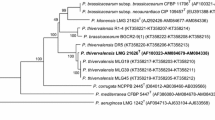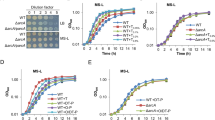Abstract
Previous work had suggested that in addition to serving the function of a siderophore, pyridine-2,6-bis(thiocarboxylic acid) (PDTC) may also provide producing organisms with the ability to assimilate other divalent transition metals. This was tested further by examining regulation of siderophore production, expression of pdt genes, and growth in response to added zinc. In media containing 10–50 μM ZnCl2, the production of PDTC was found to be differentially repressed, as compared with the production of pyoverdine. The expression of PdtK, the outer membrane receptor involved in PDTC transport, was also reduced in response to added zinc whereas other iron-regulated outer membrane proteins were not. Expression of a chromosomal pdtI:: xylE fusion was repressed to a similar extent in response to zinc or iron. Mutants that cannot produce PDTC did not show a growth enhancement with micromolar concentrations of zinc as seen in the wild type strain. The phenotype of the mutant strains was suppressed by the addition of PDTC. The outer membrane receptor and inner membrane permease components of PDTC utilization were necessary for relief of chelator (1,10-phenanthroline)-induced growth inhibition by Zn:PDTC. Iron uptake from 55Fe:PDTC was not affected by a 32-fold molar excess of Zn:PDTC. The data indicate that zinc present as Zn:PDTC can be utilized by strains possessing PDTC utilization functions but that transport is much less efficient than for Fe:PDTC.
Similar content being viewed by others
References
Andrews SC, Robinson AK, Rodriguez-Quinones F. (2003) Bacterial iron homeostasis. FEMS Microbiol Rev 27: 215–237
Auld DS (1988) Use of chelating agents to inhibit enzymes. In: Riordan JF, Vallee BL (eds) Methods in Enzymology. San Diego, Academic Press, pp. 110–114
Blatny JM, Brautaset T, Winther-Larsen HC, Karunakaran P, Valla S. (1997) Improved broad-host-range RK2 vectors useful for high and low regulated gene expression levels in Gram-negative bacteria. Plasmid 38: 35–51
Brandon MS, Paszczynski AJ, Korus R, Crawford RL (2003) The determination of the stability constant for the iron(II) complex of the biochelator pyridine-2,6-bis(monothiocarboxylic acid). Biodegradation 14: 73–82
Braun V (1997) Surface signaling: novel transcription initiation mechanism starting from the cell surface. Arch Microbiol 167: 325–331
Budzikiewicz H, Hildebrand U, Ockels W, Reiche M, Taraz K. 1983 Weitere aus dem Kulturmedium von Pseudomonas putida isolierte Pyridinderivate-Genuine Metaboliten oder Artefakte? Z Naturforschung 516–520
Canovas D, Cases I, de Lorenzo V. (2003) Heavy metal tolerance and metal homeostasis in Pseudomonas putida as revealed by complete genome analysis. Environ Microbiol 5:1242–1256
Choudhury R, Srivastava S. (2001) Zinc resistance mechanisms in bacteria. Curr Sci 81: 768–775
Cleton F, Turnbull A, Finch C. (1963) Synthetic chelating agents in iron metabolism. J Clin Invest 42: 327–337
Cornelis P, Matthijs S. (2002) Diversity of siderophore-mediated iron uptake systems in fluorescent pseudomonads: not only pyoverdines. Environ Microbiol 4: 787–798
Cornelis P, Bouia A, Belarbi A et al. (1989) Cloning and analysis of the gene for the major outer membrane lipoprotein from Pseudomonas aeruginosa. Mol Microbiol 3: 421–428
Cortese MS, Paszczynski A, Lewis TA et al. (2002) Metal chelating properties of pyridine-2,6-bis(thiocarboxylic acid) produced by Pseudomonas spp. and the biological activities of the formed complexes. Biometals 15:103–120
Cox CD, Rinehart KL Jr., Moore ML, Cook JC Jr. (1981) Pyochelin: novel structure of an iron-chelating growth promoter for Pseudomonas aeruginosa. Proc Natl Acad Sci USA 78: 4256–4260
Dybas MJ, Barcelona M, Bezborodnikov S et al. (1998) Pilot-Scale evaluation of bioaugmentation for in-situ remediation of a carbon tetrachloride-contaminated aquifer. Environ Sci Technol 32: 3598–3611
Espinet P, Lorenzo C, Miguel JA, Bois C, Jeannin Y. (1994) Palladium complexes with the tridentate dianionic ligand pyridine-2,6-bis(thiocarboxylate),pdtc. Crystal structure of (n-Bu 4 N)[Pd(pdtc)Br]. Inorg Chem 33: 2052–2055
Ferguson AD, Deisenhofer J (2004) Metal import through microbial membranes. Cell 116: 15–24
Finney LA, O’Halloran TV. (2003) Transition metal speciation in the cell: insights from the chemistry of metal ion receptors. Science 300: 931–936
Hildebrand U, Lex J, Taraz K et al. (1984) Untersuchungen zum Redox-System Bis-(pyridin-2,6-dicarbothioato)-ferrat(II)/-ferrat(III). Z Naturforschung 39b:1607–1613
Hildebrand UHW, Lex J. (1989) Untersuchungen der Struktur von Co(III)-und Ni(II)-Komplexen der Pyridin-2,6-di(monothiocarbonsaure). Z Naturforsch 44b: 475–480
Höfte M, Buysens S, Koedam N, Cornelis P. (1993) Zinc affects siderophore-mediated high affinity iron uptake systems in the rhizosphere Pseudomonas aeruginosa 7NSK2. Biometals 6: 85–91
Klecka GM, Gibson DT. (1981) Inhibition of catechol 2,3-dioxygenase from Pseudomonas putida by 3-chlorocatechol. Appl Environ Microbiol 41:1159–1165
Kruger HJ, Holm RH. (1990) Stabilization of trivalent nickel in tetragonal NiS4N2 and NiN6 environments: Synthesis, structures, redox potentials, and observations related to [NiFe]-hydrogenases. J Am Chem Soc 112: 2955–2963
Laemmli UK (1970) Cleavage of structural proteins during the assembly of the head of bacteriophage T4. Nature 227: 680–685
Leach L, Lewis TA 2006 Identification and characterization of Pseudomonas membrane transporters necessary for utilization of the siderophore pyridine-2,6-bis(thiocarboxylic acid) (PDTC). Microbiology 152, 3157–3166
Lee CH, Lewis TA, Paszczynski A, Crawford RL. (1999) Identification of an extracellular catalyst of carbon tetrachloride dehalogenation from Pseudomonas stutzeri strain KC as pyridine-2,6-bis(thiocarboxylate). Biochem Biophys Res Comm 261: 562–566; erratum 265, 770
Lewis TA, Cortese M, Sebat J et al. (2000) A Pseudomonas stutzeri gene cluster encoding the biosynthesis of the CCl4-dechlorination agent pyridine-2,6-bis(thiocarboxylic acid). Environ Microbiol 2: 407–416
Lewis TA, Paszczynski A, Gordon-Wylie SW et al. (2001) Carbon tetrachloride dechlorination by the bacterial transition metal chelator pyridine-2,6-bis(thiocarboxylic acid). Environ Sci Technol 35: 552–559
Lewis TA, Leach L, Morales SE et al. (2004) Physiological and molecular genetic evaluation of the dechlorination agent, pyridine-2,6-bis(monothiocarboxylic acid) (PDTC) as a secondary siderophore of Pseudomonas. Environ Microbiol 6: 159–169
Meyer JM, Halle F, Hohnadel D et al. (1987) Siderophores of Pseudomonas – biological properties. In: Iron Transport in Microbes, Plants and Animals. Weinheim: VCH Verlagsgesellschaft mbH, pp. 189–205
Morales SE, Lewis TA. 2006 Transcriptional regulation of the pdt gene cluster of Pseudomonas stutzeri KC involves an AraC/XylS family transcriptional activator (pdtc) and the cognate siderophore pyridine-2,6-bis(thiocarboxylic acid) (PDTC). Appl Environ Microbiol (in press)
Mossialos D, Meyer JM, Budzikiewicz H et al. (2000) Quinolobactin, a new siderophore of Pseudomonas fluorescens ATCC 17400, the production of which is repressed by the cognate pyoverdine. Appl Environ Microbiol 66: 487–492
Neilands JB, Nakamura K (1985) Regulation of iron assimilation in microorganisms. Nutr Rev 43: 193–197
Neu MP, Matonic JH, Ruggiero CE, Scott BL (2000) Structural characterization of a plutonium (IV) siderophore complex: single-crystal structure of Pu-desferrioxamine E. E Angew Chemie Int Ed Engl 39:1442–1444
Neu MP, Johnson MT, Matonic JH, Scott BL. (2001) Actinide interactions with microbial chelators: the dioxobis[pyridine-2,6-bis(monothiocarboxylato)] uranium(VI) ion. Acta Cryst C57: 240–242
Ockels W, Romer A, Budzikiewicz H. (1978) An Fe(III) complex of pyridine-2,6-di-(monothiocarboxylic acid)-A novel bacterial metabolic product. Tetrahedron Lett 36: 3341–3342
Patzer SI, Hantke K. (1998) The ZnuABC high-affinity zinc uptake system and its regulator Zur in Escherichia coli. Mol Microbiol 28: 1199–1210
Patzer SI, Hantke K. (2000) The zinc-responsive regulator Zur and its control of the znu gene cluster encoding the ZnuABC zinc uptake system in Escherichia coli. J Biol Chem 275: 24321–24332
Poole K, McKay GA. (2003) Iron acquisition and its control in Pseudomonas aeruginosa: Many roads lead to Rome. Front Biosci 8: 661–686
Rossbach S, Wilson TL, Kukuk ML, Carty HA. (2000) Elevated zinc induces siderophore biosynthesis genes and a zntA-like gene in Pseudomonas fluorescens. FEMS Microbiol Lett 191: 61–70
Schalk IJ, Yue WW, Buchanan SK. (2004) Recognition of iron-free siderophores by TonB-dependent iron transporters. Mol Microbiol 54: 14–22
Stolworthy JC, Paszczynsk A, Korus R, Crawford RL. (2001) Metal binding by pyridine-2,6-bis(monothiocarboxylic acid), a biochelator produced by Pseudomonas stutzeri and Pseudomonas putida. Biodegradation 12: 411–418
Visca P, Colotti G, Serino L et al. (1992) Metal regulation of siderophore synthesis in Pseudomonas aeruginosa and functional effects of siderophore-metal complexes. Appl Environ Microbiol 58: 2886–2893
Wandersman C, Delepelaire P. (2004) Bacterial iron sources: from siderophores to hemophores. Annu Rev Microbiol 58: 647
Acknowledgements
The authors would like to thank George Clark for sharing X-ray diffraction data prior to publication. Funding for this work was supplied by the Vermont Agricultural Experiment Station.
Author information
Authors and Affiliations
Corresponding author
Rights and permissions
About this article
Cite this article
Leach, L.H., Morris, J.C. & Lewis, T.A. The role of the siderophore pyridine-2,6-bis (thiocarboxylic acid) (PDTC) in zinc utilization by Pseudomonas putida DSM 3601. Biometals 20, 717–726 (2007). https://doi.org/10.1007/s10534-006-9035-x
Received:
Accepted:
Published:
Issue Date:
DOI: https://doi.org/10.1007/s10534-006-9035-x




